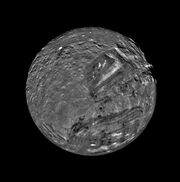
Miranda.
Miranda (pronounced /mɨˈrændə/ mə-RAN-də) is the smallest and innermost of Uranus' five major moons.
It was discovered by Gerard Kuiper on 1948-02-16 at McDonald Observatory. It was named after Miranda from William Shakespeare's play The Tempest by Kuiper in his report of the discovery.The adjectival form of the name is Mirandan. It is also designated Uranus V.
So far the only close-up images of Miranda are from the Voyager 2 probe, which made observations of the moon during its Uranus flyby in January, 1986. During the flyby the southern hemisphere of the moon was pointed towards the Sun so only that part was studied. It is geologically the most active body in the Uranian system.
Physical Characteristics[]
Miranda's surface may be mostly water ice, with the low density body also likely containing silicate rock and organic compounds in its interior.
Miranda's surface has patchwork regions of broken terrain indicating intense geological activity in the moon's past, and is criss-crossed by huge canyons. Large 'racetrack'-like grooved structures, called coronae, may have formed via extensional processes at the tops of diapirs, or upwellings of warm ice. The ridges probably represent extensional tilt blocks. The canyons probably represent grabens formed by extensional faulting. Other features may be due to cryovolcanic eruptions of icy magma. The diapirs may have changed the density distribution within the moon, which could have caused Miranda to reorient itself, similar to a process believed to have occurred at Saturn's geologically active moon Enceladus. Miranda is one of the few bodies in the solar system in which the equatorial circumference is shorter than the pole-to-pole circumference, likely a consequence of the diapir activity.
Miranda's past geological activity is believed to have been driven by tidal heating at a time when its orbit was more eccentric than currently. Early in its history, Miranda was apparently captured in a 3:1 orbital resonance with Umbriel, from which it subsequently escaped. The resonance would have increased orbital eccentricity; resulting tidal friction due to time-varying tidal forces from Uranus would have caused warming of the moon's interior. In the Uranus system, due to the planet's lesser degree of oblateness, and the larger relative size of its satellites, escape from a mean motion resonance is much easier than for satellites of Jupiter or Saturn. Miranda's orbital inclination (4.34°) is unusually high for a body so close to the planet. Miranda probably escaped from its resonance with Umbriel via a secondary resonance, and the mechanism of this escape is believed to explain why its orbital inclination is more than 10 times those of the other large Uranian moons (see Uranus' natural satellites).
An earlier theory, proposed shortly after the Voyager 2 flyby and now out of favor, was that a previous incarnation of Miranda was shattered by a massive impact, with the fragments reassembling into the current strange pattern.
Approaching the 2007-12-07 equinox, Miranda produced brief solar eclipses over the center of Uranus. Scientists recognized the following geological features on Miranda.